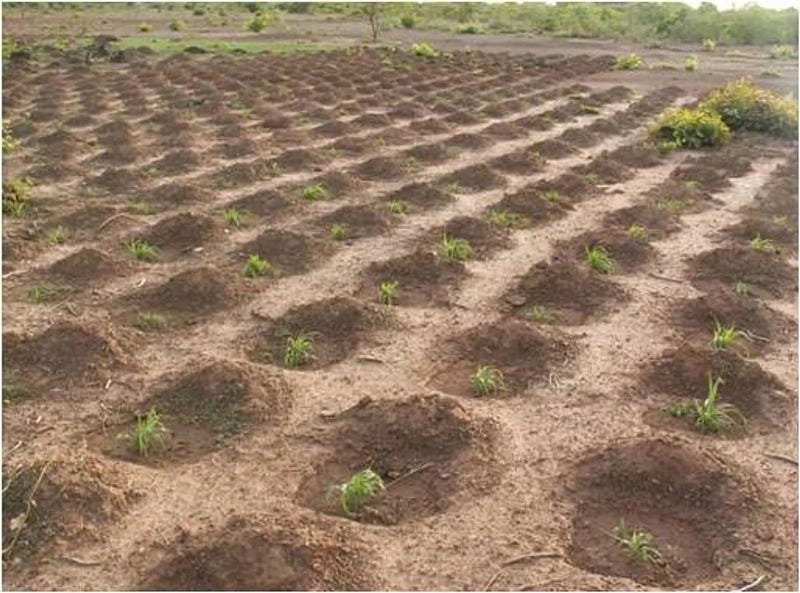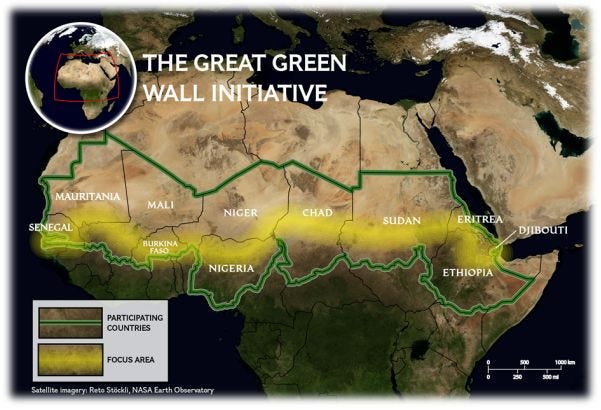A New Wonder of the World: The Great Green Wall Initiative
Written on
Chapter 1: Understanding the Sahel Region
The Sahel is one of the most severely impacted areas globally due to land degradation and desertification. This semi-arid region spans Africa, lying between the Sahara Desert and tropical savannahs.
Throughout most of the year, the area experiences dryness, receiving rain predominantly in a brief season between June and August, with an average precipitation of 100–200 mm (4–8 inches). However, the effects of climate change have made these rainfall patterns increasingly unpredictable. The landscape consists of grasslands and savannahs, representing one of the largest dryland regions worldwide.
The economic repercussions of land degradation are stark, leading to elevated food prices, malnutrition, and insecurity in water and energy resources. Such challenges pose significant barriers to development, affecting approximately 135 million individuals reliant on degraded land.
During the colonial era, Sahelian farmers learned to separate crops from trees and to clear land for agriculture. After gaining independence, new laws were introduced, often based on colonial regulations, which stated that trees on a farmer's land belonged to the government and could not be cut down for fuel. The intention was to conserve forests; however, this resulted in unintended consequences as enforcement was inadequate.
With the removal of trees, the exposed topsoil became parched and was swept away by the winds. The absence of trees also led to rainwater running off rather than being absorbed by the soil. Consequently, water levels in wells began to plummet. Combined with prolonged drought, crop yields dropped to below 200 kilograms (400 pounds) per acre, in stark contrast to the US, which averages 2540 kilograms (5600 pounds) per acre.
The Vision
The concept of establishing a green barrier against the Sahara desert originated in 1952 with pioneering environmentalist Richard St. Barbe Baker during a significant expedition across the Sahara. Baker envisioned a thirty-mile (48 km) wide "Green Front" that would encompass 24 African nations. Over the following three decades, he championed this idea, leading to the planting of more trees than anyone else in history.
Despite this ambitious vision, the initiative encountered numerous obstacles. Simply planting trees across the Sahel had a low chance of success due to a lack of scientific backing, insufficient funding, and large uninhabited areas that could not support the young saplings. Tragically, around 80% of the planted trees perished.
However, the project was not a failure. Since the late 1970s and early 1980s, farmers in the region began experimenting with innovative techniques.
Farmer-Managed Natural Regeneration (FMNR)
In Niger, farmers, with assistance from Tony Rinaudo of Serving in Mission, adopted a method known as farmer-managed natural regeneration (FMNR). This cost-effective approach to growing and sustaining trees and shrubs offers food, fuel, and fodder.
FMNR is based on the observation that beneath cleared soil, living roots and tree stumps can still produce new shoots. Farmers identify a suitable stump, select the straightest stem to nurture, and prune competing branches to encourage growth.
This adaptable technique allows farmers to modify practices according to their specific goals and circumstances, such as planting other crops in shaded areas. The presence of trees decreases wind speed and evaporation. Some species, like the winter thorn acacia (Faidherbia albida), even enrich the soil with nitrogen, enhancing fertility.
An impressive 88% of farmers in the Serving in Mission project area now practice FMNR, adding approximately 1.25 million trees annually.
Zaï Pits
Zaï pits, akin to demi-lunes, are a traditional planting technique from Burkina Faso's Yatenga Province. Farmers dig a grid of planting pits in hard soil and incorporate organic matter like manure—an innovative addition, as traditional zaï pits were smaller and lacked organic material.
These pits enhance soil fertility in multiple ways:
- They concentrate water and nutrients where they are needed most.
- Organic matter attracts termites, which break it down, making nutrients readily available to plant roots.
- As termites tunnel through the compact soil, they facilitate deeper water penetration, improving retention.
These pits can retain water for extended periods, enabling plants to endure dry spells. Farmers can dig the pits at any time, preparing them for upcoming rains.

The use of improved pits has rapidly spread. In 1984, a farmer named Yacouba Sawadogo organized market days to promote these pits, allowing farmers to showcase various crop varieties cultivated in them. By 2000, his initiative attracted farmers from over 100 villages.
Additionally, other farmers began establishing zaï schools to train peers within their communities. The areas rehabilitated over the past three decades are estimated to range between 200,000 to 300,000 hectares, contributing to food security for over 500,000 individuals.
As the trees flourish and diversity increases, water levels in wells in rehabilitated regions have improved. Small vegetable gardens around these areas enhance nutrition and provide additional income for locals.
Farmers can now keep livestock closer to fields, as ample fodder and crop residues support more intensive farming practices. While manure was primarily used for energy two decades ago, it is now returned to the soil to enrich its quality.
The benefits of these techniques are particularly pronounced for Sahelian women. As the availability of firewood improves, women can allocate their time to other essential tasks, such as meal preparation and childcare. Women involved in FMNR have gained stronger economic positions and improved access to nutritious food for their families.
The Great Green Wall (GGW)
In 2010, 11 Sahel countries south of the Sahara (Senegal, Mauritania, Mali, Burkina Faso, Niger, Nigeria, Chad, Sudan, Eritrea, Ethiopia, and Djibouti) established the Pan-African Agency of the GGW. Their goal is to restore 100 million hectares of degraded land.
This vision has evolved into an integrated ecosystem management strategy, incorporating a variety of land use and production systems, including sustainable restoration, native vegetation regeneration, water retention, and biodiversity conservation.
According to the 2020 GGW report, the initiative has received robust international support as a flagship program for combating land degradation, desertification, drought, climate change, biodiversity loss, poverty, and food insecurity. Uniquely owned by African nations, it reflects a strong political commitment to enhancing living conditions and preserving ecosystem services in the Sahel.

Numerous countries are taking action to safeguard, restore, and sustainably manage natural ecosystems through local, national, or global restoration initiatives. The total potential for restoration is 600 million hectares, as the GGW initiative has expanded across three dryland regions: North Africa (northern Sahara), the Sahel, and Southern Africa.
International efforts include the Bonn Challenge, AFR 100 (African Forest Landscape Restoration Initiative), and collaborations with organizations such as the African Union, FAO, World Bank, IUCN, UN, and EU.
The GGW directly contributes to six UN Sustainable Development Goals:
- No poverty: Generates 89.9 million USD through income-generating opportunities.
- Zero hunger: Enhances food security via sustainable land management practices.
- Decent work and economic growth: Creates permanent and temporary jobs for approximately 11 million beneficiaries.
- Responsible consumption and production: Trains over 221,000 individuals in sustainable production techniques in rural areas.
- Climate action: Potential to store around 500 million tons of CO2 while mitigating and adapting to climate change.
- Life on land: Restores 17.8 million hectares of land, promoting biodiversity conservation.
Additionally, it indirectly supports other UN SDGs, including good health and well-being, quality education, gender equality, clean water and sanitation, affordable and clean energy, reduced inequalities, sustainable cities and communities, life below water, peace, justice, strong institutions, and partnerships for the goals.
By 2020, activities contributing to the GGW initiative had restored or rehabilitated a total of 17.8 million hectares of land. To achieve a total of 100 million hectares by 2030, the pace of land restoration must escalate to 8.2 million hectares annually.
While much work remains, with sufficient funding and management, it is feasible to restore 100 million hectares or more of degraded land, albeit possibly not by 2030 due to challenges such as the global pandemic and the European energy crisis. Nevertheless, this initiative represents significant progress for local communities, wildlife, and ecosystems.
Thank you for reading! Trees offer essential benefits beyond shade and landscape coverage. Explore more about their advantages in this article.
The first video, "GROWING A WORLD WONDER: THE GREAT GREEN WALL," delves into the ambitious initiative aimed at restoring land and combating climate challenges across Africa.
The second video, "Sarah Toumi | The Great Green Wall, A Nature World Wonder in Africa," highlights personal stories and insights related to this monumental ecological endeavor.